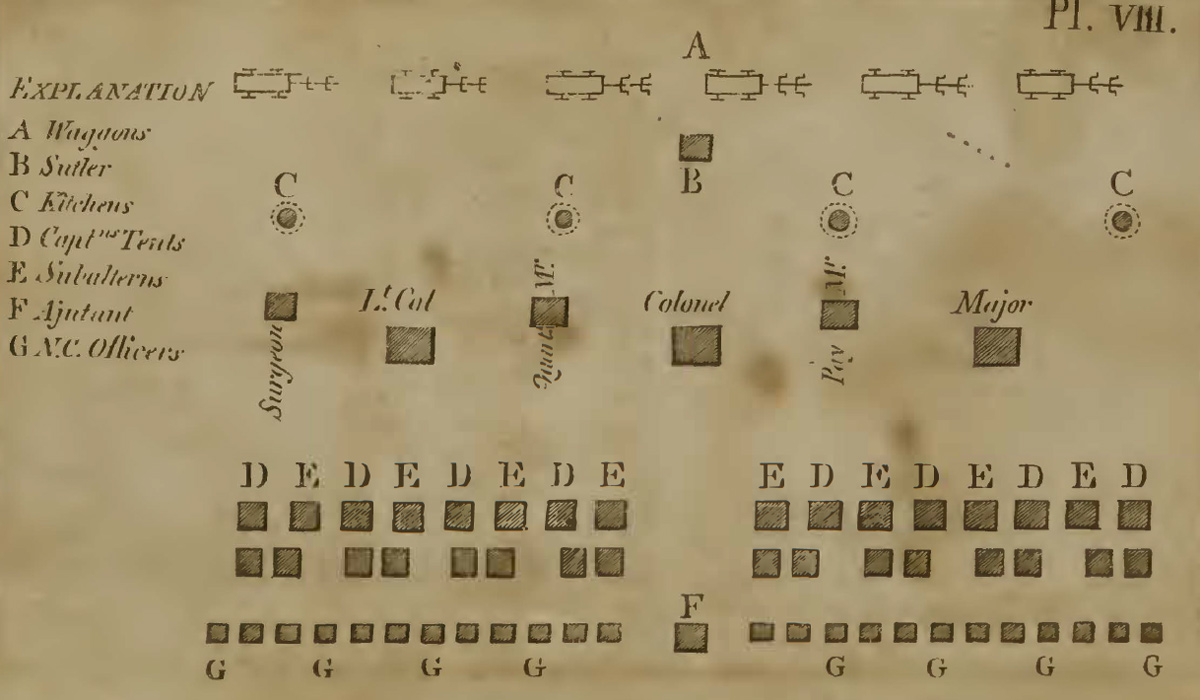Army Regulations
Friedrich Wilhelm von Steuben‘s Regulations showed two standard camp layouts, one for a regiment consisting of two battalions, the other for a one-battalion regiment. The discussion of “Order of Encampment” began with emphasis on the basic principle: “The infantry will on all occasions encamp by battalions, as they are formed in order of battle. The front of the camp will occupy the same extent of ground as the troops when formed.”[1]Baron de Stuben [sic], Regulations for the Order and Discipline of the Troops of the United States (1794; reprint, New York: Dover, 1985), 76. In other words, the camp would always be in battle order, awake or asleep, ready to spring into action.
As shown above, camp was to be arranged five rows starting with the wagons. Then came the kitchens with the sutler in the middle. The middle row consisted of the surgeon, colonels, and majors and the last two rows were for captains, subalterns, adjutant, and non-commissioned officers.
Spacing between tents, as well as lines of tents, was strictly measured. The camp for one battalion shown in the figure would have measured at least 110 feet from front to back. Privates’ tents, accommodating 6 men each, were between the sergeants’ tents; all were two feet apart. A full-strength battalion of approximately 144 men would have occupied 64 tents. The “sink,” or latrine, not shown in L’Enfant’s sketch, was to be 60 paces (300 feet) in front of the first line of tents. Camp guards were to be posted 300 paces (1,500 feet) both in front of and behind the camp.
The Military Peace Establishment Act of 1802 limited the standing army to one regiment of artillerists consisting of 20 companies, each with a total of 8 artificers[2]In the 18th and 19th centuries, artificer was a military rank, defined in the Oxford English Dictionary as “a soldier mechanic attached to the ordnance, artillery, and engineer service, to be … Continue reading and 56 privates, and two regiments of infantry of 10 companies each, with 64 privates per company. The act reaffirmed that the Army was to be governed by the existing “rules and articles of war,” but said nothing about the standards contained in Steuben’s Regulations.
Expedition Camps
It is not known with certainty how many tents the Corps of Discovery carried. In Philadelphia, Lewis ordered only nine—eight “common” tents plus one large tent for the officers. Whether they acquired more during the winter of 1803-04 to accommodate the French-Canadian hired hands, or whether the engagés were expected to bring their own, is also unanswerable. In any case, by the time they arrived at the Pacific Coast the Corps had no useable tents left at all. Even the sturdy leather tepee the captains had bought from Charbonneau at Fort Mandan was worthless. Consequently, they had no standard portable shelters from Fort Clatsop all the way back to St. Louis. At so-called Long Camp.
It seems likely that for somewhat less than the first half of the expedition the captains would have devised a simple plan—in the spirit of Baron von Steuben, perhaps—for arranging their tents whenever there was room and time enough. One day toward the end of June 1804, at the mouth of the Kansas River, Clark inserted in his journal two reminders to himself to issue new Detachment Orders—”Allarm post or order of Battle arms to be Situated & the Duty &c.,” and “Order of encampment, Tents, fires & Duty”—but no further details were written down. Nonetheless, those matters were still clearly essential to the maintenance of discipline, and the security of the command.
Additional Adaptations
For the Corps of Discovery, circumstances would affect their capacity to observe von Steuben’s rules. On 7 July 1805, for example, at the Portage Camp above the Great Falls of the Missouri, Captain Lewis noted in his journal entry: “[W]e have no tents; the men are therefore obliged to have recourse to the sails for shelter from the weather.” But even those would last very long. Moreover, he continued, “many of the men are dressing leather to cloath themselves. their leather cloathes soon become rotton as they are much exposed to the water and frequently wet.” Still later, during their torturous first crossing of the Bitterroot Mountains, and in their first rain-soaked month at the mouth of the Columbia River before Fort Clatsop was finished, the only military discipline that was possible was the officers’ regular inspection of the men’s weapons and gunpowder to insure preparedness for hunting and against surprise attacks. Finally, on rainy or snowy nights on their homeward journey, the captains surely would have permitted the men individually to seek the best natural shelters for sleeping places (large grand fir trees are usually the best), consistent with the ever-present need of camp security and readiness for action.
More than once almost all formal security procedures except the posting of sentries were out of the question. Until late at night on 12 September 1805, for instance, the men straggled down a trail on a steep mountainside to the bank of Travelers’ Rest Creek at “a very inconvenient place” where they could scarcely find a level spot to sleep. In contrast, during their stay at Long Camp (14 May 1806–10 June 1806) they placed their baggage in the sunken circular foundation of an old Indian lodge, “an eligible spot for defence,” and built their wickiups, or “tents of sticks and grass facing outwards” around its raised perimeter—faithful to the spirit, if not the letter, of Steuben’s Regulations.
Notes
| ↑1 | Baron de Stuben [sic], Regulations for the Order and Discipline of the Troops of the United States (1794; reprint, New York: Dover, 1985), 76. |
|---|---|
| ↑2 | In the 18th and 19th centuries, artificer was a military rank, defined in the Oxford English Dictionary as “a soldier mechanic attached to the ordnance, artillery, and engineer service, to be employed in the construction and repair of military materials.” |

